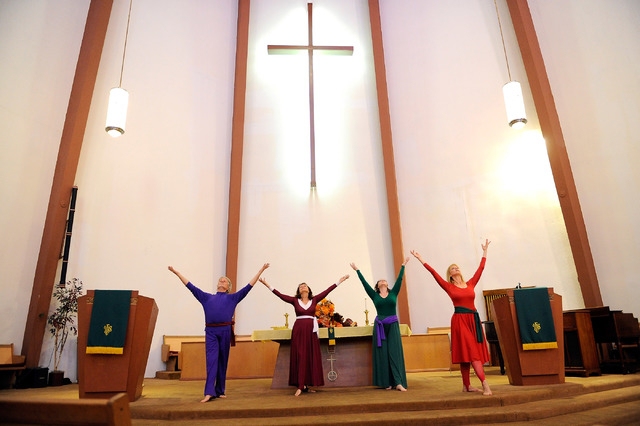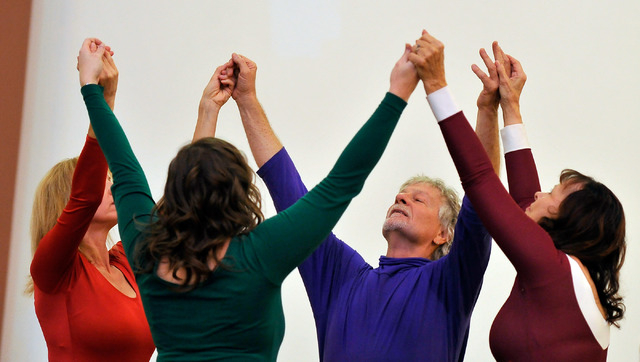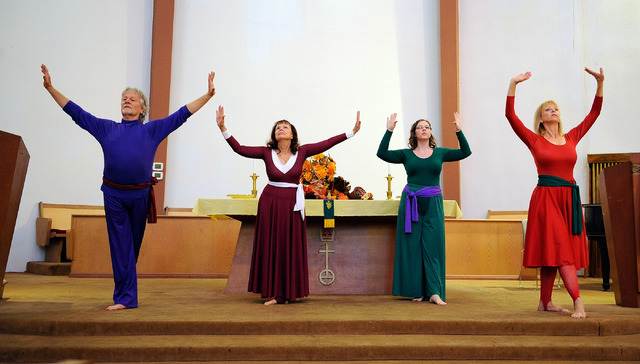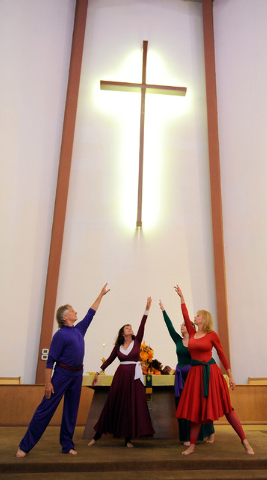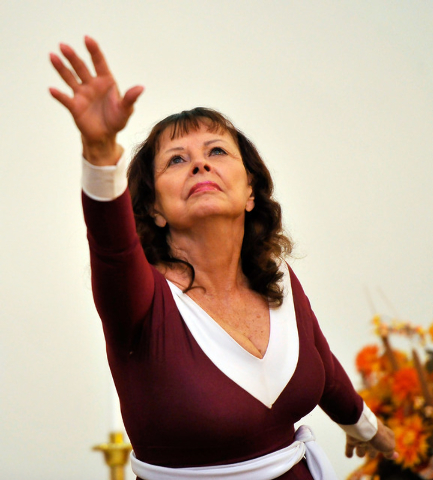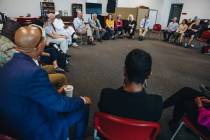Liturgical dance lifts the spirit
There’s one dance troupe in town that doesn’t hit the Strip.
The Agape Dancers call First Congregational Church/United Church of Christ their home. And, during the service Nov. 23, just a few days short of Thanksgiving, the group performed to “All Good Gifts,” from the musical “Godspell.”
Presenting about three minutes of balletlike moves in flowing, simple clothes, four dancers communicated openness and offering. Their movements segued into the service and a sermon “On Giving Thanks.”
The performance was an example of liturgical dance, a form of sacred dance. According to Wendy Morrell, president of the international Sacred Dance Guild, the “kaleidoscope of dance as a sacred art” encompasses religions ranging from Christian to Hindu, and cultures ranging from Sufi whirling dervishes to Native American.
More specifically, liturgical dance takes place in a faith-based worship service. Ann Pomeroy, the Agape Dancers’ founder and choreographer, as well as Agape performer and wife of church pastor, the Rev. Dave Pomeroy, says that the dance form can interpret any part of her church’s service. Recently, she and the group created a performance around a church statement of faith. And, at Christmas, Pomeroy was on the East Coast interpreting “O Holy Night” — with candles in hand.
“Some people find worshipping with their voice more satisfying, and other people find worshipping with their body more satisfying,” she says. “I do both.”
In addition to “lifting the spirit” and offering the congregation a different worship experience, liturgical dance “gives people an opportunity to see how you worship God with your body,” Dave Pomeroy says. “I think that is an important element to any kind of worship experience. The whole body. The voice. The reasoning. Praying. All of that is part of what worship is all about.”
Although dance has been a part of all “faith structures,” Morrell observes, the Protestant Reformation made “church and worship something that you did from the neck up.”
“I think it was Martin Luther King who said, ‘God gave us five senses, how dare we use any less in the way that we worship,’” she adds. “I embrace that model personally, and look at ways to animate or enhance the worship experience by using all the senses.”
According to Ann Pomeroy, who has been a member of the Sacred Dance Guild for 30 years and served on its board, the Agape Dancers’ performances may include some jazz movement, and usually, ballet. Through the Sacred Dance Guild, she’s attended festivals every two years — and has often come home with a piece she can use, with attribution to the choreographer.
Her group has consisted of one to nine members. And, people who have never danced before can learn to dance with the group.
Other people, such as Agape Dancer Marcus Bugler, bring a lifelong commitment to the process. Bugler performed professionally with the Metropolitan Opera in New York for three decades. He’s known Pomeroy for nine years. In fact, he’s her ballet teacher at Nevada Ballet Theatre.
“She’s in every class, unless she’s not in town,” he says. “Every day.”
Pomeroy asked him to join the group a few years ago. The bottom line as to why he continues, he says: “Spiritual connection and spiritual pleasure.”
“It’s also within the realm of ability,” he says. “I can’t get out there and do double tours anymore!”
More complex performances take more preparation time, such as the statement of faith, which took approximately 2½ months, Pomeroy says. The Nov. 23 performance took four weeks of rehearsal time.
That meant five practices, according to Jessica Henthorn, who has danced with the group for more than two years, ever since Pomeroy invited her to join. She doesn’t dance outside of church.
“It’s a great way for us to express ourselves beyond just words. You get to feel it more than just say it,” she adds.
The result was “relaxing” for at least one member of the congregation serving chocolate chip cookies after the service to the two energized young boys she had in tow. Catherine Moliterno’s life in Las Vegas without a car — an existence always either on foot or by bus — didn’t appear so relaxing in the church cafeteria.
“I thought it was very beautiful, very soothing,” she says of the performance. “Very in rhythm.”
But people do sometimes still perceive dance through the lens of “an old Puritan reaction,” Pomeroy says. Nevertheless, the Pomeroys have brought the concept of the Agape Dancers to their congregations over the years, going all the way back to Dave Pomeroy’s first congregation, the People’s Church in Long Beach, N.Y. That era of gyrating hips and the rising tide of rock star sexual frankness, from 1964 to 1968, didn’t bode well, at first, for movement in church.
“They were initially very uncomfortable with it,” the pastor says of his first congregation. “It took us awhile to get them to realize that it wasn’t what they saw on television.”
What sets sacred dance apart from the cultural mores of “The Ed Sullivan Show” and Britney Spears — and for that matter, what makes a liturgical dance performance “good” — is a mystery worth contemplating.
Morrell says she’s seen dancers who were simply performing.
“I have seen bad liturgical dance,” she says. “And I have seen liturgical dance that I don’t think is sacred.” But when the dancer’s heart and soul is evident, “for me, that’s what I’m looking for.”



